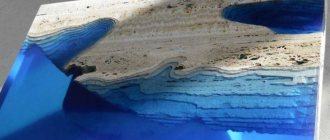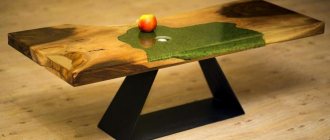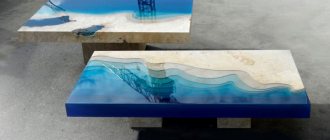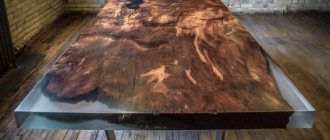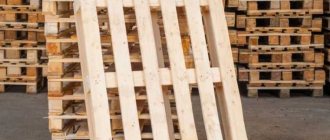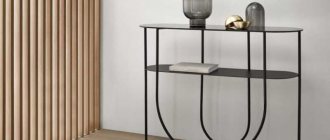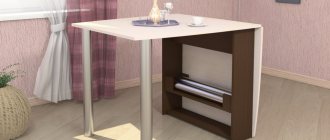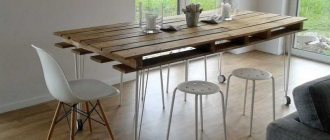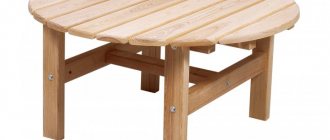Epoxy resin is a material from which you can make very diverse works - from budget jewelry to expensive designer furniture. The handmade product is unique in itself, and numerous decorative options make the craftsman’s possibilities almost limitless. Many creators sooner or later have the idea to consider epoxy resin products as a business.
Epoxy resin table top
Equipment
The required set of tools and equipment depends on the type of products being manufactured. Let's look at a sample list:
- tools - mini drill, jewelry scales, tweezers, grinding machine for surface treatment;
- silicone molds (molds) for filling;
- furniture - table and chair, rack and shelves for storing materials;
- consumables: syringes, cups, stirring sticks;
- personal protective equipment – respirator and gloves;
- tools for working with wood (if a combination of resin and wood is planned) - milling machine, jigsaw, etc.
Resin molds
What materials are needed to create epoxy jewelry?
To achieve success in developing and making jewelry from epoxy resin, patience and free time alone will clearly not be enough. To create original jewelry you will need special materials and tools. In order for the process to proceed quickly and without unplanned delays, you will need:
- high-quality epoxy resin with the required level of transparency and ductility, manufactured in accordance with GOST 10587-84;
- materials for decoration (the choice depends on the preferences of the master and customer demand);
- gloves for work, silicone molds (molds), a respirator, stirring sticks or toothpicks;
- To protect the table you will need cleaning napkins; you can use plastic film.
Of all the items noted, materials for decoration are of greatest interest. These can be plants, leaves, flowers (dried herbarium), buds, inflorescences, wood blanks. In addition to these materials, you can use decorative sand, pebbles, and shells. All products that will be used in work must be clean and dry.
It is worth noting the fittings, which are an important element when creating jewelry. These are components without which it is difficult to make brooches, earrings, pendants and other jewelry. The quality of the fittings must be high. If you do not have independent experience in making such products, then it is better to order them in a specialized store or online.
Room
If you plan to make jewelry in small quantities, you can organize a home workshop. It is advisable that this be a separate room that can be well ventilated. An insulated loggia or balcony are also good options.
To make larger items, you cannot do without a full-fledged workshop.
On average, an area of 20 to 50 m² will be sufficient. You need to look for a room either already with a hood, or with the ability to remove it. It is necessary to consider a workplace (large table), storage space for consumables and the location of equipment. If master classes are planned, it is necessary to provide work places for students. In addition, in this case, the location of the future workshop is important - good transport accessibility will be important.
You should look for either an industrial premises or a vacant premises. Sometimes workshop space can be found in Houses of Culture and Houses of Creativity.
You can look for a workplace in a ready-made workshop - craftsmen often look for co-tenants to reduce costs.
Workshop
Premises requirements
To locate your business you will need premises. Art school or workshop classes are best. As for the requirements, they are not very strict. So, the classroom in which you are going to conduct classes must accommodate at least 5 people and have a good and strong table. Since epoxy resin does not have a positive effect on the body in an uncured state, the vapors should be removed from the room. Therefore, the room for master classes must have good ventilation.
Considering the fact that classes will be held weekly, get ready for
payment of rent in the amount of 16,000 rubles. It is possible that master classes will be
order clients to come to your facility. This way you can set your own price tag depending on your expected expenses.
Sales points
Possible options where you can sell epoxy resin products:
- souvenir shops and gift shops, jewelry, household goods;
- special sites for selling handmade goods, the most popular platform in Russia is the “Fair of Masters”, for selling goods abroad – “Etsy”;
- social media;
- own website;
- trade fairs;
- working directly with designers (for selling furniture, paintings, interior items) or stylists (for selling jewelry).
Decoration
We can say that not all technologies have yet been mastered in the manufacture of furniture from epoxy. New ideas constantly push masters to create the next exclusive. Color shades are just one direction in creating a design. Decoration of countertops is carried out by adding various components to the composition. At the same time, the surface of the barrel cover still remains smooth. Any surface, textured or smooth, can be coated with resin. Light objects should be attached to the base, otherwise they may float in the resin. They pour into the tabletop everything that is subject to the master’s imagination. These could be pebbles, cones, shells, coins, flowers or leaves. Since the resin is poured in layers, the presence of objects in each layer gives a three-dimensional image.
When working with wood, the bark is left behind. Small cracks or chips, knots and wormholes are even more valuable than solid wood. The bark is also left on the wood. You just need to make sure that wood dust does not fall from the array, because it will float in the resin in the form of a suspension. Large decorative items include cutting boards, saw cuts, large stones, and decorative stone tiles.
Good to know > How to create stunning epoxy resin pendants
For those who want to emphasize the high cost of the product, craftsmen advise adding precious metals, marble chips, pearls and even some memorable souvenirs to the resin. In our case, table legs are not considered, since no resin is used in their manufacture, however, it is the responsibility of the craftsman to choose a suitable design. The legs must have a style combination with the tabletop, so metal, stone, and wood are used as materials.
The target audience
Once you have decided what products you want to sell, you need to understand who your target audience is.
Traditional divisions by gender, age and place of residence are not suitable for selling the results of creative work. After all, both a man and a woman, both at 30 and at 60, can buy, say, a painting made of epoxy resin.
The target audience should be sought at the level of values. As a rule, people do not buy creative works to solve a problem. They buy because they like it, because your products fit into their lifestyle or ideal image of it.
In order to understand your client, answer (preferably in writing) the following questions:
- what qualities of the product are important for the client;
- where and how he shops;
- what are his life values;
- his hobbies, interests;
- what he dreams of, what kind of life he wants to lead.
Find your values and meanings, decide how to broadcast them through your personal brand, visual communication, service, and communication with customers. Demonstrate this at all points of contact with the audience - advertising banners and photos, website design, packaging, personal communication, etc.
Divide your audience into groups and write down the characteristics of each separately, based on the questions provided.
Using scrap materials to decorate products.
Main types
The popularity of epoxy tables grew almost instantly. Previously, the resin was used as an adhesive, but not so long ago another area of application was discovered. Epoxy resin has become a real gift for those who are seriously thinking about interior styling. In the interior decoration of the room, not the last place is given to furniture. By the way, a piece of furniture can perform an exclusively decorative function. In particular, epoxy tables turn into interior elements. The capabilities of the material allow you to create exclusive masterpieces.
It is not possible to describe the variety of tabletop designs due to the numerous artistic variations. In the simplest classifications, tables can be divided into categories according to their functional purpose: kitchen table, coffee table, coffee table, desk. There is another classification - by type of production. But since it also determines the design of the countertop, it is quite suitable for consideration.
- Tabletops without base. These tabletops are a slab entirely cast from resin, which can have different shapes, from a disk to a prism. Due to the transparency of the material, various objects can be placed inside the slab to act as decoration. When a dye is added to the resin, an array with a tint is obtained. Various powders allow you to reduce the transparency of the resin. Since there is no rigid base, such tables are not intended for high loads. The pouring table is used as a beer, coffee or coffee table. In some cases, tables stand without any practical use at all, only for decoration.
- Table tops with base. The base performs a protective function and gives the structure additional strength. The basis is a sheet of chipboard, slab, multiplex or even an old countertop. The resin is poured on top, forming a transparent layer. As in the case of tabletops without a base, here you can also decorate the product with various elements. Due to the fact that the base below is strong, the resulting tabletop can withstand high loads. Similar products are used in the production of dining tables or work tables.
- Combined tables. Due to the fact that epoxy has fluidity, it is possible to construct combined models. They cannot be classified either in the first or in the second group. The tabletop includes fragments of wood, stone or metal, but they may not act as a base. In various variations, elements of various shapes are used, with processed and unprocessed edges, sharp or rounded edges. Tabletops with wooden elements are especially valued, since the structure of natural wood has its own originality. When producing combined tabletops, the sides are made, and decorative elements are placed inside. First, the master must coat the elements layer by layer with resin so that it gets into all the cavities. Then a flat surface is formed.
Useful to know > What epoxy resin backlit tables look like, what they are like and how they are made
Taxes
The most suitable and profitable options for how a master can legally sell his work is to register as an individual entrepreneur or self-employed.
IP Features:
- when registering, a state fee is paid;
- Insurance premiums must be paid annually regardless of revenue;
- it is necessary to submit a tax return;
- you can hire employees.
Features of self-employment:
- registration with the tax office is free;
- tax is paid only on sales, there is no need to pay insurance premiums;
- no reporting required;
- You cannot hire employees;
- The revenue limit is 2.4 million rubles. in year.
If a master is planning a small business without assistants, of course, it is more profitable to be self-employed.
If expansion and recruitment are required in the future, you can always switch from one tax regime to another.
Some may argue that you can work unofficially, but there are a number of disadvantages behind this decision. Firstly, you will not be able to set up payment acceptance on the site. The buyer will be forced to place an order, then transfer money to a card or e-wallet. This makes the selling process more difficult. In addition, a transfer to an individual’s card may raise suspicions of fraud, which may alienate potential clients. Working officially, the master can issue a receipt, which strengthens the buyer’s trust in him.
In addition, the ability to provide documents will be important when selling products through stores.
Official activity strengthens consumer confidence.
The range of decorative products provides ample opportunities for creativity.
Manufacturing technology
Review articles on epoxy resin products indicate that they are quite expensive. For example, the price of a kitchen table can exceed one hundred thousand rubles. And then the advantages of the product indicate its inexpensive cost. There is uncertainty that needs to be resolved. Indeed, the cost of an epoxy table suggests affordability. But by cost we mean all the costs of independent production. Those models that are presented in the store or made to order are considered handmade products. The main part of the final amount is formed solely due to the fame of the master.
As has already become clear, there is simply no factory production of resin countertops. Whether the countertop is made to order by professionals or made by hand, the technology for its manufacture is absolutely identical. The whole process can be divided into stages.
- choice of epoxy resin;
- preparatory work;
- fill;
- grinding.
All issues related to the manufacture of countertops are of interest to users in terms of the possibility of independent work. Here the position is based on two radically opposing versions. The first is that even experienced craftsmen pour the resin by hand. Therefore, following the step-by-step instructions, anyone can master this procedure. However, there are many pitfalls in the listed stages, and everything is not as simple as it seems. The slightest deviation from the recommended algorithm sometimes leads to irreversible negative consequences.
Resin selection
The process of selecting epoxy usually begins after creating the first sketch of the future table. If you do not have sufficient experience, you should focus on universal requirements: the resin must be transparent and resistant to external factors. The store may not offer an option for making furniture, because as such, this category of building material does not exist. You will have to select the epoxy yourself. It is recommended to immediately exclude the popular ED-20 model. It is too thick, so air cavities will form during the pouring process. When mixing resin with hardeners, a composition that is very unstable over time is obtained.
EpoxyMaster 2.0 is considered the best option for beginners. It is recommended to use it if there is no proper experience, since the thickness of one layer can reach 5 cm, that is, there is no need for layer-by-layer filling. EpoxyMaster 2.0 has good fluidity, which eliminates the occurrence of errors, and the surface is smooth without additional smoothing.
In addition, the resin interacts well with many materials. If the countertop is decorated with metal or wood, then after pouring there is no peeling or cracking. Another quality you should pay attention to is the lack of bleaching. Note that some resins become cloudy over time and become covered with a white coating.
Preparatory work
Pouring resin should only be done in a ventilated area. Temperature is of decisive importance. The temperature indicator should not be lower than 22°C degrees. Moisture and dust negatively affect the results obtained.
Preparatory work includes the production of formwork; it is constructed regardless of the type of future countertop. The material you can use is laminated chipboard plywood or plexiglass. In order for the resin to better adhere to the formwork walls after hardening, the latter should be treated with a special substance. At home, wax is suitable. As a last resort, the walls are treated with cosmetic Vaseline. But it is impossible to apply it in an even layer; moreover, cloudiness is observed in the places where Vaseline and resin come into contact. After the epoxy has hardened, the ends of the tabletop will have to be carefully sanded.
Every master class and every instruction says that you must use personal protective equipment during the pouring process. These include: glasses, respirator, gloves. To avoid dust, lint or hair getting into the liquid resin, it is recommended to wear overalls and a cap. All objects located in close proximity to the work area are covered with plastic film.
From the auxiliary materials and tools you will need a container for preparing the finished solution, scales or measuring cups. The resin and components are calculated using the formula provided by the manufacturer. The instructions indicate the mass of resin and hardener or their proportional ratio. Practice shows that the absence of resin shrinkage allows you to use a universal formula. With a layer thickness of 1 mm per 1 sq. m of area, 1.1 kg of the finished mixture is consumed. Considering that the standard EpoxyMaster package weighs 1.35 kg, 4 packages will be required to make 1 m2 of countertop (with a thickness of 5 mm).
Fill
Even professional craftsmen, when starting work, read the instructions from the epoxy manufacturer. Assembling the formwork is not the final part of the preparation. Resin can leak through the cracks, so the gaps between the walls should be treated with sealant, plasticine or hot melt adhesive.
Wooden formwork, like wooden decorative elements, contains some air inside. If it begins to separate, bubbles will form in the thickness of the resin. To prevent this undesirable phenomenon, you can treat wooden surfaces with the same epoxy composition applied a little earlier. Furniture varnish, such as polyurethane material, is also excellent. This procedure manages to “kill two birds with one stone.”
- Firstly, air from the wood will not escape into the resin.
- Secondly, the dye, if present, will not penetrate the fibers of wooden decorative elements.
Useful to know > How to fill an insect with epoxy resin, simple technology
If it is necessary to obtain a colored composition, the dye is added not to the hardener, but to the main component before mixing it. It is advisable to start adding paint in small portions to avoid irreversible consequences. Pre-heating of the base composition is allowed in order to better dissolve the dye. The components are mixed in the ratio that is necessarily indicated in the instructions. The “lifetime” of the solution is several hours. You should pay attention to this when making your own. The longer the specified time, the greater the likelihood that all air bubbles will come to the surface.
The pouring itself in technological terms is an elementary operation, however, if you decide to make a table with your own hands, you will have to provide for several nuances, which will be discussed below.
Drying time depends on the type of composition. Typically, one layer can dry for 2-3 days, so the process of creating a masterpiece cannot be called quick. Experienced specialists speed up drying by increasing the temperature. But novice masters are not recommended to do this. At high temperatures, additional air bubbles will begin to form inside the layer.
Grinding
When working with resin, it is important to maintain post-curing time. This is the time required for the seemingly solid resin to achieve its final properties. Some compositions are ready for use without post-curing. Detailed information can be found in the instructions.
Sanding and polishing will improve the visual effect of the cured resin. To prevent the tabletop from overheating under the influence of friction forces, grinding work should be carried out on a wetted surface. First you will have to process the edges of the tabletop. In places where they come into contact with the formwork, unevenness may form. The plane itself is treated with a material with fine abrasive, gradually reducing the size of the granules. Eventually sanding gives way to polishing. If immediately after the resin has hardened, a cloudy coating forms on the surface, do not despair, this is a normal phenomenon that will disappear after polishing.
Epoxy, unfortunately, changes its physical properties with prolonged exposure to ultraviolet radiation. Polyurethane varnish has protective properties. It is applied in several layers followed by sanding. If everything is done correctly, the resin will not turn yellow over time.
Initial Investment
The initial investment in an epoxy resin business varies greatly depending on what kind of products you plan to make. The amounts for the production of costume jewelry and for the production of furniture, when additional expensive materials and equipment are needed, will vary greatly. For convenience, we will consider an average option - the production of costume jewelry and paintings, approximately 10 pieces of jewelry and 3 small paintings per month. The master works as a self-employed person and sells products through social networks.
Let's consider the necessary investments and purchase of materials for a month of work:
- resin and hardener - for jewelry you will need jewelry resin; the cost of a 300 g jar together with the hardener is approximately 800 rubles. For paintings, you need material marked Resin Art, the cost of 1.5 kg is about 1,500 rubles. In total, the resin will cost 2,200 rubles;
- materials for decoration - quantity depends on the artist’s idea, approximately 3,000 rubles;
- accessories for jewelry – 2000 rubles;
- basis for paintings – 1500;
- silicone molds – 1000 rub.;
- personal protective equipment – respirator, gloves – 2500 rubles;
- consumables – cups for mixing resin, syringes – 500 rubles;
- advertising – 3000 rubles;
- tools (mini drill, jewelry scales, etc.) – 3,000 rubles;
- furniture for the workshop (table, chair, storage racks) – 4,000 rubles;
- workshop rental – 20,000 rub.
The approximate initial investment for a small business producing epoxy resin products is a little more than 40,000 rubles. Also think about whether some expenses can be avoided or minimized. For example, you probably already have some furniture or tools. To reduce rental costs, you can rent a room together with another master.
Storage racks
It is worth budgeting for unforeseen expenses - approximately 20%.
Epoxy resin tables as a business
In general, everything related to the production of furniture and interior items is currently in trend. But this article will talk about the use of epoxy resin in the manufacture of furniture. And this is not only the production of various tables, mirrors, cutting boards using various types of wood, but also other interior items. The golden color of natural wood and the shimmer of various colors of epoxy resin create works that are unique to the eye. It often turns out that a thing made in this way is unique, since it was made in one copy. With the right approach, you can create unique designer items, and this is worth a lot. Especially these days when everything is copied and stamped.
Products using epoxy resin have their pros and cons. The advantages include the following:
· Excellent performance properties. The material is durable, not afraid of mechanical damage, cracks and chips do not form during operation;
· The cost of epoxy resin is affordable and as a result, the product is obtained at reasonable prices;
· Moisture resistance and wear resistance of the product;
· Caring for furniture using epoxy resin is not difficult and does not require additional expenses.
The main disadvantages of working with epoxy resin are defects due to incorrect manufacturing technology and non-compliance with proportions, as well as damage to the product can occur due to improper processing with various abrasives. Also, you should not place hot objects on furniture using epoxy resin, as the resin can release harmful substances.
The main product in which epoxy resin is used are various countertop options. They come in several types:
· Tabletop made entirely of epoxy resin, transparent, interspersed with dried flowers, coins, etc.
· Table tops coated with epoxy resin
· Combined tabletops using wood. Wood cuts, boards of various shapes, etc. are used.
As additions to the manufacture of countertops, marble chips, foil, various beads, pebbles, semi-precious stones, etc. are used. Various dyes and luminescent powder are added to the resin.
To make a table, both wood and epoxy resin must be carefully selected. Cheap formulations usually quickly become cloudy and yellow. Mix epoxy with hardener strictly according to the instructions. There are different viscosities of epoxy resin and it is required to be used depending on the option of the selected countertop:
· Liquid resin. It flows easily from the stick, saturates the wood well, penetrating into all pores;
· Semi-liquid resin. Often used to make decorative items, round tables using wood;
· Thick resin, used for decorations and table restoration. It is not suitable for making new tables using wood.
You need to take your time when making tables from epoxy resin. To fill the tables you need to make a mold; glass is usually suitable for this. You can also make the sides of the mold from boards and put plastic film on the bottom. The resin must be poured carefully, the maximum layer thickness is 5-6 mm; a spatula is used for leveling. If the thickness is greater, then the filling is done in several stages. After pouring the first layer, you need to wait 2 days. After hardening, the product is sanded, polished and varnished. When grinding, water is periodically poured onto the surface of the product to prevent overheating. When the resin hardens, if the product is exposed to sunlight, it may turn yellow; when working in the cold, the top layers may delaminate. The ideal temperature for work is 20-22 degrees, ventilation is available. The standard mixture consumption per 1 m2 is 1.1 liters when pouring a layer 1 mm thick. When adding dye, 100 grams of dye per 2 liters of mixture.
Equipment to get started:
· The assembly table, in fact, on which the main work will take place;
· Additional tools and materials – clamps, sandpapers, hair dryer (to expel mixture bubbles), glue gun, trimmers, bucket, brushes, etc. Also don't forget about personal protective equipment.
The amount of costs depends on the product. The minimum markup is 50-80%. Advertising for finding clients on the Internet, social networks. Don’t rush to give tables to boutiques for sale; sell them yourself, since your product is a one-off and no one except you can tell you correctly about the wood. If you work alone, you can make 8-10 tables in a month.
This is one of the options for a garage business, since you can start it by owning or renting a garage. For the first time, a production area of 20 m2 will be enough. Good luck in business.
Modern and non-standard furniture manufacturing techniques are becoming increasingly in demand. For example, a table made of wood and epoxy resin can be an excellent alternative to conventional products. With the right approach, you can create real designer items. This could be a great idea to start your own business. First of all, you need to figure out how to make a table from epoxy resin and wood with your own hands and where to start.
Advantages and disadvantages
Availability and large selection of materials.
Possibility to diversify the assortment - from jewelry to furniture.
The possibility of scaling a business means hiring employees with a subsequent increase in production volumes and earnings, and developing other areas, for example, training and master classes.
High competition.
Inhaling epoxy resin vapors is quite harmful; protective equipment must be used;
It takes time to achieve a high level of skill.
Beginner mistakes
What are the common mistakes that novice businessmen make:
- trying to save on materials - the result of your work and comfort during the creation of products will depend on their quality;
- they grab onto everything at once - it’s better to first make one type of product, promote it to the market, and then open new horizons;
- expect instant results - developing any business takes time, lack of sales at first is normal, give yourself time to promote and don’t give up on the business you started.
Registration and organization of business
Before starting your own countertop production business, it is recommended that you familiarize yourself with the specifics of this product and the nuances that will need to be taken into account in the future.
Types of countertops
Depending on the material, there are several types of countertops, differing in their properties, production costs and, accordingly, the final price.
- Products laminated with chipboard.
This material is fade-resistant and wear-resistant, withstands cleaning agents well and hardly loses color over time. Thanks to modern technologies, countertops can have different patterns and textures - for example, granite, a beautiful painting or stone.
To make the product more reliable, its underside is covered with kraft paper. This version of the countertop has a relatively low price, but has one significant drawback - if water gets on the unprotected areas of the product, they can swell and become deformed.
- Stainless steel countertops are moisture-resistant and durable.
Decorative designs can be applied to steel sheets. The most practical option is a matte finish. The disadvantage of such countertops is that their solid surface can only have a rectangular shape, that is, it cannot be made into a corner.
- Solid wood countertops look very nice.
However, caring for them requires special care and should not be treated with caustic detergents. The appearance of the product depends on the type of wood used. The better it is, the more the cost of the countertop will be. The wood is processed using special technologies, and the surface is coated with oil, which, penetrating deep, becomes invisible. This product is perfectly protected from moisture.
- Another type of countertops is represented by acrylic products.
Their main advantage is the difference in seamless shapes. Acrylic stone is quite strong and moisture-resistant, environmentally friendly and shock-resistant. The disadvantage of such a product is that it is sensitive to high temperature and technical damage.
- Countertops made of agglomerate.
Products made from this material are thinner than others because it is made without a backing frame. This is possible due to the moisture resistance of this material. Another advantage of such countertops is that they are not afraid of aggressive washing and hot dishes. In appearance they are very similar to stone ones, but much lighter. The disadvantage is that the agglomerate is quite cold to the touch. Moreover, if such a countertop is damaged, it will be impossible to repair it.
- Countertops made of natural stone (basalt or granite).
They are very beautiful and can decorate any kitchen, the main thing is to choose the color of the product harmoniously with the overall interior. Of course, the cost of such a product is much higher, but it also looks more luxurious and richer. In addition, such a countertop does not leave marks from objects, scratches or detergents.
Premises and equipment
To start producing countertops, you will need to rent a space of at least fifty square meters.
There are no special requirements for the premises.
The main subtlety of such a business is that most often countertops of non-standard shape are required, which are made according to an individual project . Therefore, it is not advisable to use a stationary format-cutting machine in this case. To work with artificial stone you will need hand power tools :
- a powerful router, which is necessary for adjusting seams, smoothing out irregularities and for making shaped elements;
- a jigsaw without a pendulum stroke, designed for cutting sheets;
- a grinding machine used to polish the surface of products.
Mandatory equipment for the workshop will be assembly tables . You will also need consumables:
- Attachments for power tools.
- Trimmers.
- Sanding skins.
- Polishes.
- Glue gun.
- Clamps.
Suppliers and raw materials
Today, all manufacturers of plastic-lined countertops use CPL and HPL materials. Until now, the big problem for kitchen furniture manufacturers has been the swelling of chipboards, but now almost all suppliers offer a range of waterproof components. Such slabs are produced in Balabanovo "Plitspichprom", MK "Shatura". A more economical option would be to purchase wood panels from the Volgodonsk plant.
The Russian center for the production of countertops is St. Petersburg, which is explained by its proximity to Finland, where moisture-resistant polished slabs are purchased. The most famous is the Soyuz PG.
Construction plastic produces.
Many countertop manufacturers work with several materials at once.
For example, you can purchase waterproof chipboard panels from, artificial stone countertops from GetfCora, and solid wood from Werzalit.
Countertops made of artificial stone are in increasing demand. In recent years, companies supplying this material have been constantly holding seminars for those who wish to work with it. They offer not only the composite itself, but also all the additional materials needed to work with it. As a result, many companies are opening that are ready to sell this material.
There are samples on the market in a wide variety of price categories, designed for different buyers. In addition to European companies, there is material from Korean and Taiwanese companies, which costs much less.
Today, all types of components: glass, steel, solid wood are offered in Russia. For cooperation, you can consider existing proposals and choose the most acceptable option for yourself.
Production technology
Despite its apparent simplicity, the manufacture of countertops will require special knowledge and qualifications. Half of the success is provided by consumables, the rest depends on the professional skills of the employees.
It is also important to strictly adhere to safety rules to avoid injuries at work.
Let us present the main stages of the technological process for the manufacture of countertops using the example of a countertop made of artificial stone:
- making a drawing;
- transferring the contours onto plywood, which is previously cleaned of dust and degreased;
- applying epoxy resin (glue) to plywood;
- cutting the material according to the specified parameters; fastening artificial stone to plywood using special holders;
- processing the edges of the tabletop in order to obtain uniform cuts;
- gluing the main part with the sides;
- creating holes for a sink or for household appliances;
- final sanding and polishing.
Staff
Due to the nature of countertop production, personnel must have certain qualifications. You shouldn't skimp on your salary. A qualified specialist will not work for pennies, and the demand for products directly depends on his skills.
Sales market
Countertop manufacturers work directly with furniture companies.
By conducting an advertising campaign correctly, you can establish a permanent sales market.
And since furniture manufacturing is always in demand, there will be no stagnation in business.
